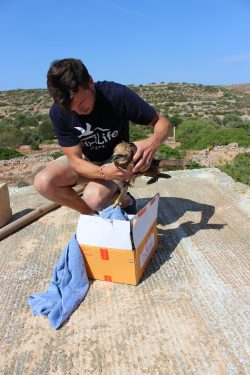On the 12th of April, BirdLife Malta received a call from a member of the public about an injured bird. This is the story of Reġina, her rescue, rehabilitation and release.
The phone rang at the office.
It was a call for an injured bird found in Miġra l-Ferħa. Possibly a Marsh Harrier they said. Probably shot. Immediately we got into the car with our equipment; a cardboard box with newspaper to transport the bird safely to the vet and a camera to film the incident.
We arrived on site and took a hold of the bird, she was bleeding and her right wing seemed injured. After carefully placing her into the cardboard box, we immediately transferred her to the vet where our worst fears were confirmed; the injury was the result of a gunshot, resulting in a broken ulna. Despite the trauma of the gunshot, the bird’s radius remained intact meaning she could be rehabilitated ad stood a chance of being released back into the wild. We decided to name our new rehabilitant Reġina, meaning ‘queen’ in Maltese.
site and took a hold of the bird, she was bleeding and her right wing seemed injured. After carefully placing her into the cardboard box, we immediately transferred her to the vet where our worst fears were confirmed; the injury was the result of a gunshot, resulting in a broken ulna. Despite the trauma of the gunshot, the bird’s radius remained intact meaning she could be rehabilitated ad stood a chance of being released back into the wild. We decided to name our new rehabilitant Reġina, meaning ‘queen’ in Maltese.
During the first week, Reġina could not even lift herself off the ground and had a poor appetite. By the second week, she began to use the perches and was eating two chicks per day. On the third week, Reġina was transferred to a bigger space to enable her to exercise her wings. She started soaring and flying really high, we were amazed! We called the vet immediately and told her the good news. The vet took the decision to perform another x-ray to see how the wound was healing and thankfully, the x-ray showed that the bone was healed and the injury was stabilised. Her rapid recovery took us all by surprise! Before she could be released, the vet recommended another week in our care to exercise her wing.
By the end of week four, Reġina was fit enough to be released and was taken to Comino where the day’s winds were in her favour! The southwesterly winds meant that she could continue her epic migration journey north in order to breed and reproduce.
Hopefully the unique identification ring placed on her leg will allow us to track her and learn where she ended up breeding in the future!
By Antaia Christou, BirdLife Malta Conservation Assistant
